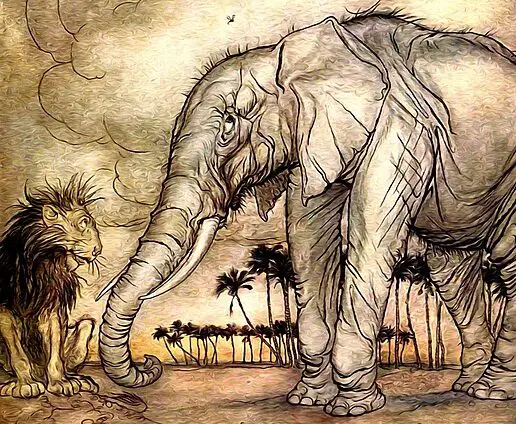Fables are a type of folk literature that typically feature animals or inanimate objects with human-like qualities and are intended to teach a moral lesson or practical truth, whereas fairy tales are stories that often involve magical or supernatural elements and are intended to entertain and inspire wonder in readers. Fairy tales typically involve human characters and often have a more complex plot than fables, which tend to be more straightforward and focused on the lesson being taught.
What is the definition of a fable?
(Image by Prawny from Pixabay )

A fable is a short story that typically features anthropomorphic animals, plants, inanimate objects, or forces of nature that are given human qualities and characteristics. Fables can be moral stories, teach a lesson, or simply entertain. The word “fable” comes from the Latin word fabula, meaning “story”.
Fables are often confused with fairy tales; however, there are some distinct differences between the two genres. Fairy tales typically feature magical creatures and have a fairy-tale ending (e.g., “happily ever after”). Fables, on the other hand, do not necessarily have a moral lesson or happy ending. Additionally, while fairy tales often take place in fantastic worlds remote from our own experiences, fables usually take place in familiar settings.
Some well-known examples of fables include Aesop’s Fables and La Fontaine’s Fables.
What is the definition of a fairy tale?
(Photo by Molly Triplett on Unsplash )

A fairy tale is a type of short story that typically features folkloric fantasy characters, such as fairies, goblins, elves, trolls, dwarves, giants or gnomes, and usually magic or enchantments. Fairy tales may be distinguished from other folk narratives such as legends (which generally involve belief in the veracity of the events described) and explicitly moral tales, including beast fables.
The term itself comes from the translation of Madame D’Aulnoy’s Conte de fées, first used in her collection in 1697. The number of types and subgenres of fairy tale is difficult to determine. The broadest definition includes any story with fantastic elements, no matter how small. Even if these stories don’t have any supernatural elements, they are still considered fairy tales.
One popular type of fairy tale is the quest story, in which a young hero or heroine goes on a journey in order to complete a task or achieve a goal. This can be seen in stories like Beauty and the Beast, Sleeping Beauty, Hansel and Gretel, and Rapunzel. Other common motifs include talking animals, cursed children, wicked stepmothers/fathers, glass mountains, and helpful strangers.
Fable Vs. Fairy tale – Key differences
Fables and fairy tales are both forms of literature that often feature anthropomorphic animals and magical elements, but there are some key differences between the two:
Moral lesson: Fables are intended to teach a moral lesson or a practical truth, while fairy tales are more focused on entertainment and imagination.
Characters: Fables typically feature animals or inanimate objects with human-like qualities, while fairy tales usually have human characters, although they may include fantastical creatures.
Setting: Fables often take place in a realistic, everyday setting, while fairy tales take place in a fantastical, fictional world.
Plot: Fables usually have a simple, straightforward plot, while fairy tales often have more complex and intricate plots.
Tone: Fables are often more didactic and serious in tone, while fairy tales are more whimsical and light-hearted.
Authorship: Fables are usually attributed to a specific author or culture, while fairy tales are often part of a larger oral tradition and have unknown origins.
Fables are typically used as a tool for teaching a moral lesson, while fairy tales are more focused on storytelling and enchantment.
Examples of fables
Fables are stories that typically feature anthropomorphic animals, plants, inanimate objects, or forces of nature. The moral of a fable is usually stated explicitly at the end of the story.
Aesop’s Fables are perhaps the best-known examples of fables. These stories were first collected in the 6th century BC and continue to be popular today. Other well-known fables include La Fontaine’s Fables, The Town Mouse and the Country Mouse, The Lion and the Mouse, The Ant and the Grasshopper, and The Fox and the Grapes.
Fables can be found in many different cultures and languages. They often have a universal appeal because they deal with topics that are relevant to human nature, such as greed, vanity, pride, laziness, and envy.
Examples of fairy tales
Many popular fairy tales were written by the Brothers Grimm, including “Hansel and Gretel,” “Rapunzel,” and “Cinderella.” Other examples of well-known fairy tales are “Snow White,” “Sleeping Beauty,” and “Beauty and the Beast.” These stories often feature magical elements, such as talking animals, evil witches or step-mothers, and heroes or heroines who triumph in the end.
What is the difference between folktale and fable stories?
There are many differences between folktale and fable stories. Folktales are usually about everyday people and their lives, while fables often feature animals or inanimate objects as the main characters. Folktales can be either true or fictional, while fables are always fictional. Folktales are typically passed down orally from generation to generation, while fables were traditionally written down and published.
Folktales typically have a moral or lesson at the end, while fables always have a moral. The moral in a folktale is usually more implied than stated outright, while the moral in a fable is always stated explicitly. Finally, folktales can be any length, while fables are usually quite short.
What are the types of fairy tales?
Fairy tales are a type of folk literature that have been told and retold for centuries, often with variations based on different cultural contexts. While there are many different versions of fairy tales, here are some common types:
- Animal tales: These are stories in which animals are given human characteristics and are the main characters.
- Wonder tales: These are stories in which magical or fantastic events take place, often involving enchanted objects or characters.
- Romance tales: These are stories in which romantic relationships and love are a central theme.
- Religious tales: These are stories that have religious themes or teach moral or ethical lessons.
- Legends and myths: These are stories that are based on historical or mythical events or characters.
- Nonsense tales: These are stories that are meant to be funny and entertaining, often with absurd or surreal elements.
- Cumulative tales: These are stories that repeat certain phrases or events, building up to a conclusion.
- Pourquoi tales: These are stories that explain why things are the way they are, often using animal characters.
- Literary fairy tales: These are stories that were written by individual authors, rather than being part of a larger oral tradition.
While these are just some examples of different types of fairy tales, there are countless variations and subgenres within this rich and diverse form of literature.
What are the characteristics of a fairy tales?
Many fairy tales contain similar characteristics, such as talking animals, magical elements, a damsel in distress, and a happy ending. However, there are also some key differences between fairy tales and other types of stories. For example, fairy tales often have a moral lesson or message, while fables usually do not. Additionally, fairy tales often feature characters with superhuman abilities or magical powers, while fables typically focus on more realistic characters.
What are the characteristics of a fables?
Fables are a type of folk literature that typically feature animals or inanimate objects with human-like qualities and are intended to teach a moral lesson or practical truth. Here are some common characteristics of fables:
- Anthropomorphic characters: Fables often feature animals or inanimate objects with human-like qualities, such as talking animals or objects with human emotions and behaviors.
- Moral lesson: Fables are intended to teach a moral lesson or practical truth, often using the actions and consequences of the characters to illustrate the lesson.
- Simple plot: Fables usually have a simple, straightforward plot that is focused on the lesson being taught.
- Allegory: Fables often use allegory, in which the characters and events in the story represent abstract ideas or concepts.
- Universal themes: Fables often deal with universal themes such as the consequences of greed, the dangers of pride, and the rewards of hard work.
- Didactic tone: Fables are often didactic in tone, meaning that they are intended to teach a lesson and are often written in a direct, instructional style.
- Short length: Fables are typically short and concise, often with a length of only a few paragraphs or pages.
Fables are intended to be simple and straightforward stories that teach a moral lesson through the actions and consequences of the characters, often using animals or inanimate objects with human-like qualities to illustrate the lesson.
Featured Image By – Brian McGowan on Unsplash








